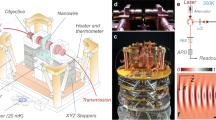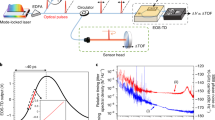Abstract
The ability to detect extremely small forces and nanoscale displacements is vital for disciplines such as precision spin-resonance imaging1, microscopy2, and tests of fundamental physical phenomena3,4,5. Current force-detection sensitivity limits have surpassed 1 aN Hz−1/2 (refs 6,7) through coupling of nanomechanical resonators to a variety of physical readout systems1,7,8,9,10. Here, we demonstrate that crystals of trapped atomic ions11,12 behave as nanoscale mechanical oscillators and may form the core of exquisitely sensitive force and displacement detectors. We report the detection of forces with a sensitivity of 390 ± 150 yN Hz−1/2, which is more than three orders of magnitude better than existing reports using nanofabricated devices7, and discriminate ion displacements of ∼18 nm. Our technique is based on the excitation of tunable normal motional modes in an ion trap13 and detection through phase-coherent Doppler velocimetry14,15, and should ultimately allow force detection with a sensitivity better than 1 yN Hz−1/2 (ref. 16). Trapped-ion-based sensors could enable scientists to explore new regimes in materials science where augmented force, field and displacement sensitivity may be traded against reduced spatial resolution.
This is a preview of subscription content, access via your institution
Access options
Subscribe to this journal
Receive 12 print issues and online access
$259.00 per year
only $21.58 per issue
Buy this article
- Purchase on Springer Link
- Instant access to full article PDF
Prices may be subject to local taxes which are calculated during checkout



Similar content being viewed by others
References
Rugar, D., Budakian, R., Mamin, H. J. & Chui, B. W. Single spin detection by magnetic resonance force microscopy. Nature 430, 329–332 (2004).
Binnig, C., Quate, C. F. & Gerber, C. Atomic force microscope. Phys. Rev. Lett. 56, 930–933 (1986).
Mohideen, U. & Roy, A. Precision measurement of the casimir force from 0.1 to 0.9 µm. Appl. Phys. Lett. 81, 4549–4552 (1998).
Volokitin, A. I. & Persson, B. N. J. Theory of friction: the contribution from a fluctuating electric field. J. Phys. Condens. Matter 11, 345–359 (1999).
Arkani-Hamed, N., Dimopoulos, S. & Dvali, G. The hierarchy problem and new dimensions at a millimeter. Phys. Lett. B 429, 263–272 (1998).
Mamin, H. J. & Rugar, D. Sub-attonewton force detection at millikelvin temperatures. Appl. Phys. Lett. 79, 3358–3360 (2001).
Teufel, J. D., Donner, T., Castellanos-Beltran, M. A., Harlow, J. W. & Lehnert, K. W. Nanomechanical motion measured with an imprecision below that at the standard quantum limit. Nature Nanotech. 4, 820–823 (2009).
Knobel, R. G. & Cleland, A. N. Nanometer-scale displacement sensing using a single-electron transistor. Nature 424, 291–293 (2003).
Lahaye, M. D., Buu, O., Camarota, B. & Schwab, K. C. Approaching the quantum limit of a nanomechanical resonator. Science 304, 74–77 (2004).
Regal, C. A., Teufel, J. D. & Lehnert, K. W. Measuring nanomechanical motion with a microwave cavity interferometer. Nature Phys. 4, 555–560 (2008).
Brewer, L. R. et al. Static properties of a non-neutral 9Be+ ion plasma. Phys. Rev. A 38, 859–873 (1988).
Biercuk, M. J. et al. High-fidelity quantum control using ion crystals in a penning trap. Quantum Inf. Comput. 9, 920–949 (2009).
Heinzen, D. J. & Wineland, D. J. Quantum-limited cooling and detection of radio-frequency oscillations by laser-cooled ions. Phys. Rev. A 42, 2977–2994 (1990).
Berkeland, D. J., Miller, J. D., Bergquist, J. C., Itano, W. M. & Wineland, D. J. Minimization of ion micromotion in a Paul trap. J. Appl. Phys. 83, 5025–5033 (1998).
Mitchell, T. B., Bollinger, J. J., Huang, X.-P. & Itano, W. M. Doppler imaging of plasma modes in a penning trap. Opt. Express 2, 314 (1998).
Maiwald, R. et al. Stylus ion trap for enhanced access and sensing. Nature Phys. 5, 551–554 (2009).
Wineland, D. J. et al. Experimental issues in coherent quantum-state manipulation of trapped atomic ions. J. Res. NIST 103, 259–328 (1998).
Turchette, Q. A. et al. Heating of trapped ions from the ground state. Phys. Rev. A 61, 063418 (2000).
Deslauriers, L. et al. Zero-point cooling and low heating of trapped 111Cd+ ions. Phys. Rev. A 70, 043408 (2004).
Labaziewicz, J. et al. Temperature dependence of electric field noise above gold surfaces. Phys. Rev. Lett. 101, 180602 (2008).
Drewsen, M., Mortensen, A., Martinussen, R., Staanum, P. & Sorensen, J. L. Nondestructive identification of cold and extremely localized single molecular ions. Phys. Rev. Lett. 93, 243201 (2004).
Staanum, P. F., Højbjerre, K. & Drewsen, M. Sympathetically-cooled single ion mass spectrometry, in Practical aspects of trapped ion mass spectrometry (eds March, R. E & Todd, J.F.J.) (CRC Press, 2010).
Major, F. G., Gheorghe, V. N. & Werthe, G. Charged Particle Traps: Springer Series on Atomic, Optical, and Plasma Physics (Springer, 2005).
Mitchell, T. B. et al. Direct observations of structural phase transitions in planar crystallized ion plasmas. Science 282, 1290–1293 (1998).
Huang, X.-P., Bollinger, J. J., Mitchell, T. B. & Itano, W. M. Phase-locked rotation of crystallized non-neutral plasmas by rotating electric fields. Phys. Rev. Lett. 80, 73–76 (1998).
Jensen, M. J., Hasegawa, T., Bollinger, J. J. & Dubin, D. H. E. Rapid heating of a strongly coupled plasma near the solid–liquid phase transition. Phys. Rev. Lett. 94, 025001 (2005).
Horowitz, P. & Hill, W. The Art of Electronics (Cambridge Univ. Press, 2006).
Stowe, T. et al. Attonewton force detection using ultrathin silicon cantilevers. Appl. Phys. Lett. 71, 288–290 (1997).
Leibfried, D. et al. Experimental demonstration of a robust high-fidelity geometric two ion-qubit phase gate. Nature 422, 412–415 (2003).
Harlander, M., Brownnutt, M., Hansel, W. & Blatt, R. Trapped-ion probing of light-induced charging effects on dielectrics. Preprint at http://arXiv.org/abs/1004.4842 (2010).
Acknowledgements
The authors thank K. Lehnert, D. Leibfried, D.J. Reilly, T. Rosenband and D.J. Wineland for useful discussions. Thanks also go to J. Kitching and U. Warring for their comments on the manuscript. The authors acknowledge research funding from the Defense Advanced Research Projects Agency (DARPA), the DARPA Optical Lattice Emulator program, and the National Institute of Standards and Technology (NIST) Quantum Information Program. M.J.B. acknowledges fellowship support from the Intelligence Advanced Research Projects Activity and Georgia Tech. H.U. acknowledges support from the Council for Scientific and Industrial Relations, South Africa. This manuscript is a contribution of NIST and not subject to US copyright.
Author information
Authors and Affiliations
Contributions
M.J.B., H.U. and J.J.B. conceived, designed and performed the experiments and co-wrote the manuscript. J.W.B. contributed to experimental measurements and data analysis. A.P.VD. assisted with optics hardware and the hardware–software interface.
Corresponding authors
Ethics declarations
Competing interests
The authors declare no competing financial interests.
Supplementary information
Supplementary information
Supplementary information (PDF 344 kb)
Rights and permissions
About this article
Cite this article
Biercuk, M., Uys, H., Britton, J. et al. Ultrasensitive detection of force and displacement using trapped ions. Nature Nanotech 5, 646–650 (2010). https://doi.org/10.1038/nnano.2010.165
Received:
Accepted:
Published:
Issue Date:
DOI: https://doi.org/10.1038/nnano.2010.165
This article is cited by
-
Ultra-sensitive measurement of transverse displacements with linear photonic gears
Nature Communications (2022)
-
Detection of DC electric forces with zeptonewton sensitivity by single-ion phonon laser
Science China Physics, Mechanics & Astronomy (2022)
-
Ultrasensitive nano-optomechanical force sensor operated at dilution temperatures
Nature Communications (2021)
-
Motional Fock states for quantum-enhanced amplitude and phase measurements with trapped ions
Nature Communications (2019)
-
Quantum lock-in force sensing using optical clock Doppler velocimetry
Nature Communications (2017)



